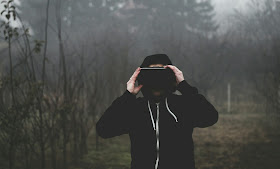Virtual reality headsets work by showing a separate image to each eye, making things look 3D. The image is displayed on a cell phone which is placed in the headset.
One difference between the cell phone based VR headsets and those that use a computer is motion tracking. Headset VR systems rely solely on the motion tracking capabilities of the phone. Computer systems have more complex tracking to detect the headset position. Also, cell phones don’t have as much graphics power as a computer, so the virtual reality environment is usually not dynamic. Changing your head position changes the location that the images are rendered from. This requires more processing power.
Though many high end VR systems provide great results to gamers, they are expensive and require powerful computers. Luckily, there are a few cheaper options available that only require a smartphone running iOS or Android. Though mobile VR headsets aren't made for intense gaming, they're a great way for anyone to experience virtual reality.
There are a few different options available for mobile virtual reality, but we’ll be sticking to those that are under $30. These headsets have different features and quality, so we’ll do our best to cover which ones are a good deal. It’s important to keep in mind that though there are many headsets available, not all are a good choice. Lots of companies write fake reviews to increase their sales.
Google Cardboard
At the low end is a product that started the mobile VR revolution, the Google CardboardOne of the main drawbacks of Google Cardboard is that it doesn’t have a strap. This means that you’ll need to be holding it against your face the entire time you use it.
View-Master Virtual Reality Starter Pack
The View-Master Virtual Reality Starter Pack
Leelbox 3D VR
The Leelbox 3D VRThis headset has adjustable lenses for pupil distance and focal distance for distortion-free viewing by people with different eyes. This product is compatible with just about any smartphone front 4.7-6.0”. It also supports many VR apps such as Google Cardboard and Google Streetview. The VersionTech headset also has holes in the side, allowing the phone to remain cool. In addition, the holes allow you to plug in headphones while using the headset.
Virtual reality is a great experience, and we definitely recommend a mobile VR headset. These allow anyone to experience virtual reality with their cell phone, without an expensive computer.




The new best smartphone vr headset provides you with a 3D visual making your virtual experience more amazing and cool. You can see each and every image clearly and analyze the atmosphere.
ReplyDelete